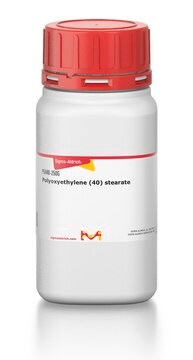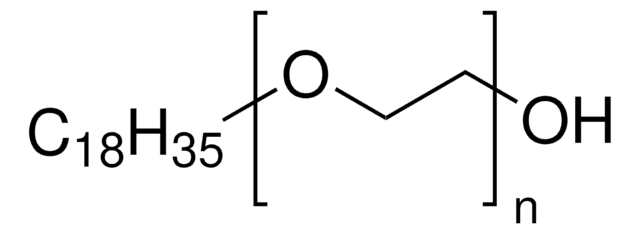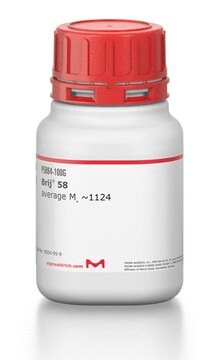466387
Brij® S 100
average Mn ~4,670
Sinonimo/i:
Polyoxyethylene (100) stearyl ether
About This Item
Prodotti consigliati
PM
average Mn ~4,670
Livello qualitativo
Punto di fusione
51-54 °C (lit.)
Indice di ossidrile
13‑25 mg KOH/g
Solubilità
propylene glycol and xylene: insoluble
Densità
1.1 g/mL at 25 °C (lit.)
HLB
18
InChI
1S/C20H41O2/c1-2-3-4-5-6-7-8-9-10-11-12-13-14-15-16-17-19-22-20-18-21/h2-20H2,1H3
PSEGVHKUPXNGGJ-UHFFFAOYSA-N
Cerchi prodotti simili? Visita Guida al confronto tra prodotti
Categorie correlate
Applicazioni
- as a non-ionic surfactant to study its interactions with luminol electrochemiluminescence for bioanalysis
- as a carrier material to study the formulation of nimodipine, fenofibrate, and o-vanillin using the particles from gas-saturated solution (PGSS) process
- as a hydrophilic surfactant in the casting solution to prepare an asymmetric flat sheet nanofiltration membranes and to study its effects on the hydrophilic property of the poly(ethersulfone) (PES) nanofiltration membranes
Note legali
Avvertenze
Warning
Indicazioni di pericolo
Consigli di prudenza
Classi di pericolo
Acute Tox. 4 Oral
Codice della classe di stoccaggio
11 - Combustible Solids
Classe di pericolosità dell'acqua (WGK)
WGK 2
Punto d’infiammabilità (°F)
Not applicable
Punto d’infiammabilità (°C)
Not applicable
Dispositivi di protezione individuale
Eyeshields, Gloves, type N95 (US)
Scegli una delle versioni più recenti:
Possiedi già questo prodotto?
I documenti relativi ai prodotti acquistati recentemente sono disponibili nell’Archivio dei documenti.
I clienti hanno visto anche
Il team dei nostri ricercatori vanta grande esperienza in tutte le aree della ricerca quali Life Science, scienza dei materiali, sintesi chimica, cromatografia, discipline analitiche, ecc..
Contatta l'Assistenza Tecnica.









